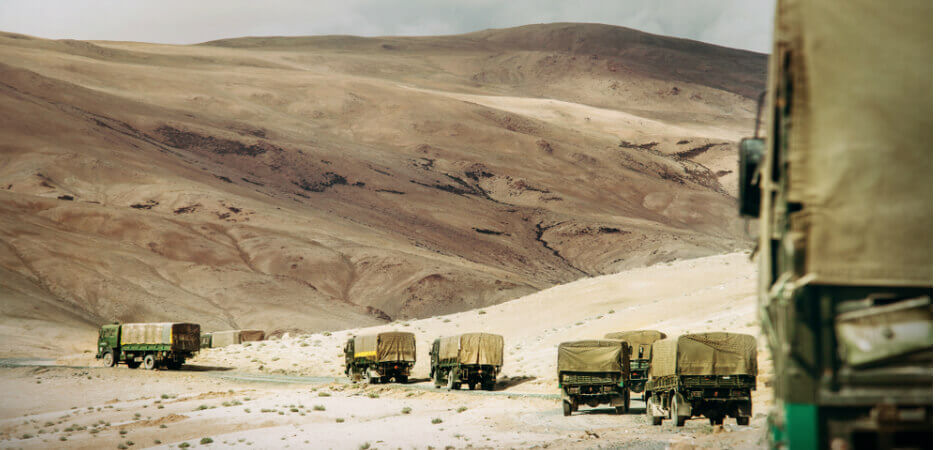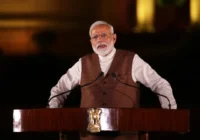India might want to explore the option of a sub-conventional military response to deter Pakistan from ceasefire violations and its proxy war against India in the Kashmir Valley.
While the global strategic community remains engaged with Iran, North Korea and Palestine, an extremely volatile nuclear flashpoint in South Asia — the India-Pakistan border — merits more attention. Since the 2003 ceasefire agreement, which followed three wars since the 1947 partition and bounds of intermittent fighting, there have been numerous instances of ceasefire violations; in the first two months of 2018 alone, India reported 633 violations, and Pakistan reported 400.
Unfortunately, there seems to be a lack of intelligence-based expert analysis of the recurring ceasefire violations along the border. However, even the basic attempts at reasoned analysis reveal that ceasefire violations are not random incidents of misadventure but are calculated strategic moves within the larger remit of Pakistan’s irregular warfare framework. For example, recent ceasefire violations have occurred in the Jammu and Kashmir region to terrorize the Hindu community that still has a strong presence in the state. The broader objectives behind such tactics are to usher in a demographic change in the region by a gradual and sustained expulsion of non-Muslims from the state, weakening India’s territorial claims.
Ceasefire violations may have a multitude of objectives, such as eroding the electoral base of Narendra Modi’s government. They can provide momentum and a morale boost to disruptive activities in the Kashmir Valley or divert attention from some large-scale infiltration attempts or other social/political unrest in other parts of the country.
The Craft of Proxy War
Understanding Pakistan’s irregular warfare is a study in itself and well beyond the scope of this article. But when it comes to its neighbor, a realistic assessment reveals India’s capabilities are highly confined for various reasons. Pakistan has mastered the craft of proxy war over the last three decades in Afghanistan and Kashmir. Pakistan holds assets in the form of separatist and radical religious groups in India-administered Kashmir and other parts of India, which does not have that advantage in Pakistan.
India could never develop a well-coordinated proactive strategy to resolve the Kashmir dispute. Its approach has mostly been ad hoc, narrow and reactionary. Prime Minister Jawaharlal Nehru took the Kashmir issue to United Nations without a serious thought and against the wishes of his deputy, Vallabhbhai Jhaverbhai Patel. In the 1990s Prime Minister P. V. Narasimha Rao followed a hard-line approach to curb militancy in Kashmir. Later, Atal Bihari Vajpayee followed with a soft approach, initiating dialogue with all sections of Jammu and Kashmir’s population. He vowed to solve Kashmir issue on the lines of insaniyat (humanity) and Kashmiriyat (giving importance to local sentiments).
After Vajpayee, during Manmohan Singh’s tenure in office, the state policy did not venture beyond maintaining the status quo. When Modi came to power in 2014, the people of Kashmir expected the revival of Vajpayee’s efforts to resolve the dispute. However, the Modi government began with a hard-fisted approach toward stone-throwers in Kashmir and blinded civilian protesters with pellet guns. At the same time, Modi formed a coalition government with People’ Democratic Party and its president, Kashmir’s former chief minister Mahbooba Mufti, whose sympathies with the separatist factions are an open secret. Whereas the central government in New Delhi wanted to get tough on civilian protesters and Pakistan, the state government led by Mahbooba Mufti advocated mercy toward the civilian protestors and dialogue with Pakistan.
After three years of this approach, the Modi government tried to mend ties by declaring generous economic packages and sent former director of the Intelligence Bureau, Dineshwar Sharma, as interlocutor with authority to negotiate with all Kashmiri groups. But, again, the government did not show enough respect toward the separatist leaders such as Syed Abdul Rahman Geelani, Yaseen Malik and Mirwaiz Umar Farooq. Besides, India seemed to lack a systematic strategy to counter Pakistan’s proxy war in Kashmir. Lt. General Syed Ata Hasnain, in his essay in The New Arthashastra: Security Strategy for India, has succinctly observed that India lacks enough experts who understand the subtle nuances of Pakistan’s proxy war strategy.
Strategic Culture
India also lacks an aggressive strategic culture needed to plan and implement systematic and sustained efforts in the field of psyops, cyberwar, information warfare, sabotage, civil unrest and political disruptions. As I have mentioned elsewhere, building deep assets for covert actions in long-range irregular warfare requires a sustained effort with clarity and continuity of policy and purpose, high morale among the concerned intelligence agencies, competence, muscle and skill, as well as a strong political will. Unfortunately, India lacks all these. In Pakistan, the military has stayed in command of the security and foreign policy apparatus for last 70 years, following a consistent strategy, clear policy objectives and sustained efforts.
Unlike Pakistan, with every election, India’s policy, personnel and entire ideology changes. It is a well-known fact that Prime Minister Morarji Desai did not have a great liking for Research and Analysis Wing (RAW, India’s foreign intelligence service) which played an exemplary role in the 1971 Indo-Pakistan war. He suspected it to be loyal to his rival and former Prime Minister Indira Gandhi. As a result, he not only curtailed its budget but inadvertently destroyed all its assets in Pakistan. After Desai, when Indira Gandhi became prime minister, RAW got its strength back.
Prime Minister Rajeev Gandhi emphasized modernization of the intelligence services. Later, in 1998, Prime Minister I. K. Gujaral once again took a U-turn and ordered RAW to cease all its operations in Pakistan. Just recently, the Modi government vowed support Baluchistan’s freedom struggle, later backtracking, allegedly under Chinese pressure.
Indian agencies lack authority, are highly bureaucratized, suffer from inter and intra-agency rivalry that was most recently evident in the failure of intelligence agencies to prevent 26/11 Mumbai terrorist attacks. In Pakistan, the military dominates state institutions, which gives intelligence agencies a say in decision-making. In India, the electoral democracy has its own compulsions. Populism dictates decision-making even if that comes at the cost of national security. Intelligence agencies often buckle under political pressure. Their scarce resources are utilized to offset domestic political rivals rather than for more serious national security issues.
Conventional War
Hence, the range of options to counter Pakistan is very narrow. India’s edge over Pakistan has always been in conventional war. This was the reason why Pakistan made strategic and tactical nuclear weapons to use as a deterrent if India resorted to a conventional full-scale attack. India’s strategic community has always held the view that Pakistan is likely to retaliate with a full-scale nuclear attack in case of a strong response from India to its terror tactics. This has been the trap set up by Pakistan’s Inter-Services Intelligence: The ISI has been funding and propping Pakistan’s proxies in Kashmir and across India for decades, but it makes sure to not push India’s patience too far.
To increase this threshold, Pakistan deliberately used the nuclear threat. India was left with no option but to bear with the sabotage and disruption orchestrated by Pakistan, lest Pakistan might retaliate with a nuclear attack.
Just how baseless and unfounded India’s fears have been is amply demonstrated by Pakistan’s low-profile response to India’s much-hyped surgical strikes across the line of control (LOC) in Kashmir. Resorting to nuclear options will be a greater disaster for Pakistan. The Pakistani army is a rational actor and understands the facts well: It does not have a response mechanism in case India retaliates with aggressive military action, short of full-scale war. Pakistan realizes that the nuclear option could be the last resort and that too in the event of a serious threat to its very survival.
However, such an opportunity may not arise in the case of a sub-conventional, short-range and swift military action by India. Pakistan will not have a convincing rationale to explain to the world community its decision to resort to disproportionate retaliation in the form of a tactical or a full-scale nuclear attack. Hence, Pakistan is not likely to retaliate with a nuclear weapon, and therein lies the chink in Pakistan’s armor. The prospect of a full-scale war with a potential for a nuclear escalation is unrealistic. India has no reason to fear a full-scale nuclear retaliation from Pakistan in response to its sub-conventional military action. Hence, with benefits outweighing the costs, India might want to explore the option of a sub-conventional military response to deter Pakistan from ceasefire violations and its proxy war against India in the Kashmir Valley.
Sub-Conventional Military Strategy
As a part of a sub-conventional military strategy, India could also consider the option of regular bouts of aggressive, high-intensity counteroffensives sustained over an extended period of time with no immediate end in sight, interspersed with perfunctory peace initiatives and diplomatic activity. The objectives of such actions would be to destroy the terror infrastructure near the LOC. Something like a strike on the terrorist organization Lashkar-e-Taiba’s headquarters in Muridke, in Pakistan, may generate robust political capital for any political party in India.
Other objectives could be making civilian life difficult in Pakistan’s border areas and undermining civilian morale, which might pressure the Pakistani army into abandoning the ceasefire lest it loses its credibility among the people as their well-wisher and protector.
An sub-conventional response by India is a highly likely scenario because of the increasing levels of frustration in the army and the increasingly worsening situation in the Kashmir Valley. India’s strategic community is expected to perceive India’s enhanced strategic footprint and the diplomatic isolation of Pakistan as conducive to an unconventional response. Next year’s elections and rising Hindu nationalism may generate the necessary domestic pressures for the current government to act more decisively.
The story does not end here, however. Pakistan has already developed tactical nuclear weapons — smaller bombs and short-range missiles aimed at achieving limited objectives. Pakistan’s acquisition of tactical nuclear weapons makes the situation more destabilizing for various reasons. First, the state is becoming dysfunctional, and society is highly radicalized. So much so that now in Pakistan one can witness the mainstreaming of Islamic militant leaders and organizations through the electoral process.
Islamic radicalization has also made deep inroads into the mid-level and junior cadres of Pakistan’s army. In such a scenario, there are strong reservations about the capability of the military to safeguard its sophisticated nuclear arsenal from falling into the hands of radicalized elements.What makes the situation more alarming is that tactical nuclear weapons need to be deployed in advance and at short-range (60 kilometers) from the target. Field commanders have sufficient authority to use them.
As long as centralized actors control policymaking and implementation in Pakistan, it is unlikely to use tactical weapons against India’s sub-conventional or conventional attack, because India’s nuclear doctrine clearly states that any kind of nuclear attack, be it tactical or strategic, will be met with retaliation. But if a radicalized mid-level field commander takes a suo motu decision to use a tactical nuclear weapon against India, then the situation may escalate into a full-scale nuclear war. Moreover, it could also happen in an accidental military skirmish with India. That may be the worst-case scenario for South Asia.
*[A version of this article was published by Asia Times.]
The views expressed in this article are the author’s own and do not necessarily reflect Fair Observer’s editorial policy.
Photo Credit: Soloviov Vadym / Shutterstock.com
Support Fair Observer
We rely on your support for our independence, diversity and quality.
For more than 10 years, Fair Observer has been free, fair and independent. No billionaire owns us, no advertisers control us. We are a reader-supported nonprofit. Unlike many other publications, we keep our content free for readers regardless of where they live or whether they can afford to pay. We have no paywalls and no ads.
In the post-truth era of fake news, echo chambers and filter bubbles, we publish a plurality of perspectives from around the world. Anyone can publish with us, but everyone goes through a rigorous editorial process. So, you get fact-checked, well-reasoned content instead of noise.
We publish 2,500+ voices from 90+ countries. We also conduct education and training programs
on subjects ranging from digital media and journalism to writing and critical thinking. This
doesn’t come cheap. Servers, editors, trainers and web developers cost
money.
Please consider supporting us on a regular basis as a recurring donor or a
sustaining member.
Will you support FO’s journalism?
We rely on your support for our independence, diversity and quality.







